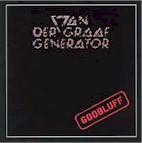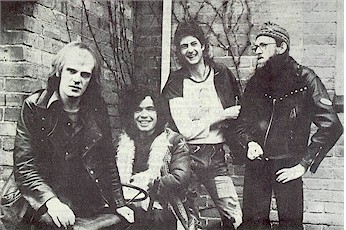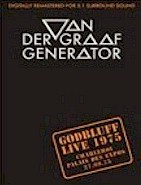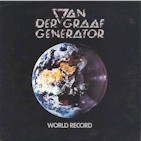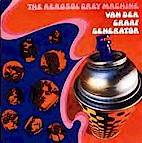
Genre: progressive
Rating: *** (3 stars)
Title: The Aerosol Grey Machine
Company: Mercury
Catalog: SR-61238
Year: 1969
Country/State: UK
Grade (cover/record): VG/VG
Comments: m
Available: 1
GEMM catalog ID: 4474
Price: $50.00
Cost: $66.00
Lots of folks think singer/guitarist Peter Hammill was the man behind Van Der Graff Generator (named after a piece of machinery that generates static electricity). Wrong. The band was actually the brainchild of student-cum-drummer Chris Judge-Smith. While attending Manchester University, Judge-Smith decided to try forming a band. Inspired by a brief vacation in San Francisco, when he returned to school, Judge-Smith convinced Peter Hammill and keyboardist Nick Peame to join him in a musical endeavor. As Van Der Graff Generation, the line up quickly went through a series of changes. By 1968 Judge-Smith had been replaced by Guy Evans, Hugh Banton replacing Peame and bass player Keith Ellis being added to the group.
In the wake of a 1968 single ('People You Were Going To' b/w 'Firebrand Polydor catalog number 56758), the band called it quits. Hammill went into the studio planning to cut a solo effort, but quickly called in his former band mates and when released in 1969, "The Aerosol Grey Machine" was creditte as a Van Der Graff Generator product.
An obscure band comprising five guys.
An obscure beat recording which is now of minor interest to some collectors. The 'A' side was a Little Richard song and the group were one of the least well known from Liverpool's Merseybeat era. McClusker was later in The Roadrunners. Compilation appearances include: What's Your Name? and Rip It Up on Rare 60's Beat Treasures, Vol. 2 (CD). (Vernon Joynson/Arthur Davies)
A Christian progressive folk album featuring mostly female vocals and entirely self-penned material. The disc is housed in a great gatefold fantasy sleeve design.
NB: (2) Unissued. Including two former Sam Gopal's Dream members, Pete Sears and former Pretty Things' drummer Viv Prince, Vamp conjured up a suitably laid back, hypnotic atmosphere on Floatin'. Rumours of a 15 minute version of Floatin' abound. Viv Prince had earlier been with The Pretty Things and Bunch Of Fives. He later played with Denny Laine. Andy Clark and Mick Hutchinson teamed up in Clark-Hutchinson and Clark was also in Upp. Pete Sears went on to US bands Silver Metre and Jefferson Starship. Compilation appearances include: Thinkin' Too Much on Magic Spectacles (CD); Floatin' on Perfumed Garden, Vol. 1 (LP & CD) and Electric Sugar Cube Flashbacks (CD).
A one-off pop 45. The 'A' side is a weak cover of The Beach Boys' hit with falsetto vocals. My Girl is given similar treatment on the flip side. The group were Irish and both sides of the 45 can also be heard on Sequel's Irish Rock - Ireland's Beat Groups 1964-1969 (CD).
This guy was later a DJ for Radio London and Radio One. Generally in this era DJs were better deployed broadcasting than making records. Both 'A' sides were Rolling Stones' compositions.
NB: (1) was originally a US-only release until Fontana released it here in 1975. (2) - (8) were all reissued by Charisma during the early eighties. (1) reissued on CD (Repertoire REP 4647) 1997, and both sides of their debut 45 are tagged on the end. (2) reissued on CD (Charisma CASCD 1007) 1987. (3) reissued on CD (Charisma CASCD 1027) 1988. (4) reissued on CD (Charisma CASCD 1051) 1988. (6) reissued on CD (Charisma CASCD 1109) 1988. (7) reissued on CD (Charisma CASCD 1116) 1987. (8) reissued on CD (Charisma CASCD 1120) 1988. Also relevant is Time Vaults (Thunderbolt/Demi-Monde CDTB 106) 1993, a collection of demos and rehearsal tapes from the band's dormant era between 1971 and 1975 and I Prophesy Disaster (Virgin CDVM 9026) 1993, a compilation of some of their 45 and album tracks. Maida Vale (Band Of Joy BOYCD 008) 1994 compiles material from the BBC's archives. Other compilations have been First Generation (Virgin COMCD 2) 1987 and Second Generation (Virgin COMCD 3) 1987 and Now And Then (Thunderbolt CDTB 042) 1988, which is also on album.
Peter Hammill formed this band whilst studying at Manchester University in 1967. Line-up (A) was very short-lived, Peame left before any recordings took place. Line-up (B) included former Koobas' bassist, Keith Ellis, and recorded the People You Were Going To 45 for Polydor. It was their only recording for that label and is now very rare and highly sought-after by fans of the band. Shortly after, they had all their equipment stolen and split up. Hammill embarked on a solo career but soon invited Banton and Evans back to assist him on what eventually became the first Van Der Graaf Generator album, Aerosol Grey Machine. Originally released in the USA on Mercury it was only available as an import in the UK until Fontana released it here in 1975. There were also two versions of the album yet the catalogue numbers and track listings were identical. One version included Necromancer, the other Squid I, an instrumental. Necromancer was also released on a 45 with Afterwards. The 45, which was only released in the US, is now another sought-after item. This debut album certainly wasn't stunning and made little impression commercially but it is worth a spin. Soon after its release Keith Ellis departed for Juicy Lucy and in the incestuous world of British rock Nic Potter, who had played with Guy Evans in the final version of The Misunderstood, replaced him. Dave Jackson (from Heebalob, who Chris Smith had left to form) also joined up on sax. |
"People You Were Going To," Judge-Smith left Van Der Graaf Generator, which by then consisted of Hammill, keyboardist Hugh Banton, bassist Keith Ellis and drummer Guy Evans. The group soon split, and in 1968 Hammill entered the studio, ostensibly to record a solo album; however, he ultimately called in his ex-bandmates for assistance, and when The Aerosol Grey Machine appeared, it did so under the Van Der Graaf Generator name.
"The Aerosol Grey Machine" track listing:
(side 1)
1.) Afterwards (Kirtley) - 4:55
2.) Orthenthian St. (Pt. 1 and 2) (Peter Hammill) - 6:18
3.) Running Back (Peter Hammill) - 6:35
(side 2)
1.) Into a Game (Peter Hammill) - 6:57
2.) Aerosol Grey Machine (Peter Hammill) - 0:47
3.) Black Smike Yen (Hugh Banton - Keith Eliis - Gary Evans) - 1:26
4.) Aquarian (Peter Hammill) - 8:22
5.) Necromancer (Peter Hammill) - 3:38
6.) Octopus (Peter Hammill) - 8:06
|
Beginning as a Peter Hammill solo effort following the dissolution of the first Van Der Graaf Generator, this quickly recorded album brought Hammill together with producer John Anthony and caused the reformation of the band (which immediately thereafter shifted personnel once again). A raw, energetic effort that sometimes did little to show off the young Hammill's talents, the album nevertheless has some fine moments that hint at the possibilities for future releases. The fact remains, mind you, that the second album, The Least We Can Do Is Wave to Each Other, is far superior. CD versions of this album appeared in 1996 and 1997, both including additional material such as the first (and very rare) Van Der Graaf Generator single, and the previously unreleased VDGG recording of "Ferret and Featherbird."
Orthenthian Street
- "The street in question does not exist, although a search for it, and
the hotel we believed it to hold among its houses, took well over an hour:
symptomatic, perhaps, of life in bands! This was the first song of mine
which dealt - if obliquely - with that lifestyle and the endless vistas of
motorways and assorted potential destructions. If it is claustrophobic and
inconclusive then that only serves to further its point."
Aquarian - "This song has a chequered history of assorted
titles and intentions: originally to be a celebration of the incoming
Aquarian Age, it went through a phase of being a hymn to an assorted band of
troubadours bound together under the aegis of a certain record company.
After the sufferance of no little trial and tribulation at the hands of this
concern, I had no regrets as I withdrew my lyrical support from it and
re-engaged the song on its old rails. Pitfalls abound in any eulogising
songs, and since this time I have been more concerned with my doubts in
songs rather than with certainties which are fickle as the seasons. Octopus - "These lyrics, dealing with a similar case of
disorientation and inability to over-view, were written in the snow-besieged
Students' Union of Southampton University. The original Octopus took the
form of a mural in the flat of the lady concerned and it is, in a way,
validatory that the relationship was neither consummated nor
clarified." "I had been engaged by Mercury Records. Peter
Hammill had a contract with them and had a problem, as they didn't want to
set the group under contract; so they gave him two days of studio to record
an album. Two days! We made "The Aerosol Grey Machine". And it was
in the Trident Studios because I liked Ken Scott, who had worked as a sound
technician on "A Salty Dog" of Procul Harum. But Scott was working
only with the biggest producers, so they gave me Robin Cable who was even
better, and in fact he recorded all Elton John's albums".
The first performance of this song was on platform 6 of Derby Midland
Station (a fine institution), to a surprisingly rapt audience of porters,
fellow-travellers and Chris Judge Smith."
- Peter Hammill from Killers, Angels, Refugees (1974)
- Peter Hammill in an interview with Mju:zik magazine,
February 1998
- John Anthony in an interview with Mju:zik magazine,
February 1998
"On Monday I was asked to produce an L.P. for the Van der Graaf
Generator, by Thursday we were in the Studio. Up until that time I had
vaguely seen the band play the Speakeasy (the playground of the stars) and
at the Marquee (the playground) and had heard them perform Octopus on the
radio, one Sunday afternoon. I had no idea what numbers we were going to do,
or any conceptions of a 'production'. What resulted is what happens when a
group 'blows' in a studio. I hope some of it comes through, as we all had a
good time. I hardly knew any of the group, but during and after two
sessions, became a friend. Peter Hammill was doing all the singing and
playing his guitar, and being cool (in the nice way). Hugh Banton ate
bananas and drank milk, played piano and organ well and pottered about
murmering. Keith Ellis smiles, played his bass and was a nice person. Guy
Evans hammered away, intelligently on his drums, and laughed a lot. Jeff
played flute on a track or so, and was very quiet.
An assorted crowd of loons were the atmosphere, were
the vocal group, were happy and were quiet, during the playback Rob
engineered professionally, everyone worked hard."
| Biography | by Jason Ankeny | |||||
|
Although Ellis was replaced by Nic Potter and woodwind player David Jackson, the reconstituted group continued on for 1969's The Least We Can Do Is Wave to Each Other. After 1970's H to He Who Am the Only One, Potter departed; the Generator recorded one more LP, 1971's Pawn Hearts, before Hammill left for a solo career, putting an end to the group. After five solo efforts, however, Hammill again reformed Van Der Graaf Generator in 1975 for Godbluff. Following a pair of 1976 albums, Still Life and World Record, Banton and Jackson exited; as simply Van Der Graaf, the band recorded The Quiet Zone with new violinist Graham Smith. After a 1978 live set, Vital, the group officially disbanded, although most members made appearances on Hammill's subsequent solo records. Twice during the 1990's, Van Der Graaf also reunited for one-off gigs. SummaryThe first album of Van der Graaf Generator was released in the US in 1969. In Europe it was only released very late in 1974. This European pressing did contain the track Necromancer, while Giant Squid was not present on this pressing. New to this release is an old version of Ferret and Featherbird also to be found on In Camera. Also note that on the vinyl versions Orthenthian St. is a two part track.The musicAfter all this talk on releases and whatever happened let's now talk of the music on this what was originally supposed to be the first PH solo album. Compared to the other VDGG albums, even compared with the follow up The Least We Can Do...., is that it sounds a lot more sixties than whatever else was done by the band.Now, I'm rather a fan of the band and this album should be seen as a historic document, a way of seeing how things led up to the later more chaotic and confronting VDGG. Although I like it less than most VDGG albums, this is not because I think the band is watered down or tired (something that I did find sometimes on the very late VDGG/VDG albums), but the style is still so much influenced by the sixties, that it sometimes seems a different band, although already a good one. Most of the tracks can stand the test of time and for instance Into A Game is quite a heavy track with very busy drumming and the second part sounding rather improvised. The titletrack is a very odd track and cannot be considered seriously and also the following psychedelic tracks Black Smoke Yen and Aquarian can not really capture my attention. Necromancer is a bit of a doubter because the chorus is a bit well naive, but at leats part of this track it has also some very good moments. On the other hand there's at least one track Octopus that already advented was what to follow later: desperate, frightening, frightened and dissonant, it holds what VDGG later stood for. ConclusionWith an extensive booklet on the story of the band and this album this is a necessary release to all those VDGG and PH fans out there. Although by far not the strongest album of the band this is still a nice album, that is more in the vein of PH solo and also still very much with the roots in the sixties, than anything they did later. The music isn't too loud or claustrophobic and confronting as that later work, but the bite in the vocals of Hammill is already present when they render his heartfelt songs. Nostalgia rides again.Next time they might try to find that early VDGG single Firebrand/People You Were Going To and include it in some package. They missed that opportunity here.
Listening to this stuff again, in the course of the remastering and preparation for this release, all the waves of time, tide and emotion swept over me. If the circumstances surrounding the recording of "The Aerosol Grey Machine" had been any different they could scarcely have been less strange; if they had been other than they were then many lives (principally my own) would have gone off on diverse courses. This collection of recordings, therefore "far off" - as they are - "in time and space", is essential in terms of any subsequent story or adventure, musical or otherwise, in which VdGG or I became involved. The seeds of everything else were sown here or hereabouts. As far as i know, the whole of the following tale has never been told, at least publicly, before now.... What follows is to the best of my recollection. It's not totally reliable and the chronology may be somewhat fluid, but you should get some flavour of the times.... 1968. You have to bear in mind that this was a fundamentally different planet. Turmoil in hearts and minds, Vietnam still in full swing, nuclear annihilation still an imminent possibility, riots in the streets, the possibility of absolute change an aspiration on the wind... Music still The Thing. I was in my first year as a Liberal Studies in Science student at Manchester, running around with the Drama Department and the Left... and with Chris Judge Smith and Nick Pearne. These two and I constituted the VdGG of this era. If memory serves, we only actually performed as a trio once, when we were bottled off stage (by medical students, of course); we had already lost our bass player, Maggie, who departed in shards of screams during a dress rehearsal at the moment when Judge emerged from behind his drum kit in full costume/Latex mask/blood capsule effect, looming towards her at the climax of a Werewolf tune. I suspect that Nick also began to question his commitment to the cause at this stage. Judge and I, however, were committed. We continued as a duo. We played at the magic village (prop: Roger Eagle, later of Eric's), supporting Tyrannosaurus (later, T) Rex among others. The general view seemed to be that we were permanently tripping. (Whether this was to do with the fact that Judge was using a manual typewriter as percussion for a significant part of the set ... takka-takka-ding!.... is a matter for conjecture in another universe.) We did contrive to acquire a manager: enter Caleb Bradley, a fellow student. Perhaps we would have been wise to take a deep breath when we saw the sign adorning the door of his bed sit: "Void is All". It was 1968... we didn't. We only wanted to Do Music. Caleb did not get to do much for us, but has an essential part to play in this story. He promised us some recording time. This turned out to be a mono session recorded at his parents' house (while they were away) somewhere on the South Coast. The guitar amp I'd been assured would be there turned out to be a TV set. I had to play in the garden to minimise the buzz. I don't have a copy of the resultant tape, but I'm fairly convinced it would have been unconvincing. Armed with it, however, Bradley managed to bend the ear of Lou Reizner (RIP), then the representative of Mercury Records in the happening-if-hard-to-understand-from-a-US-perspective UK. A Contract was in the offing. Probably it was not just the tape. Judge and I had spent some time in London after our demo experience with Caleb and somehow or other ended up at John Peel's flat regaling him with a song or so. I'm not sure if the typewriter was present or not at this stage. Some time later he entered us in his "A to Z of the Perfumed Garden" as being a (possibly the only) "V" item of interest. I guess that was enough to swing it for Lou.... As I say, the UK and London was hard to understand on that other, 1968, planet. Somewhere around this time, Judge and I began, not before time, to have our doubts about Caleb Bradley. We did not want to be signed to him, or for him to sign us up to somebody else. Cue Lawyers? Heavies? A gentle word? Tantrums? In fact, cue the two of us rushing down to London, avec amps, avec drum kit, avec Latex mask, up the stairs of the Knightsbridge block, into the office and...play. To Lou, behind his desk. Demo tapes? Promo videos? Marketing packages? Not in those days. Lou must have been somewhat taken aback, but this escapade clinched The Deal. So it came to pass that the Mercury contract was directly with us; the nineteen-year-old (under-age), legally unrepresented, eager Van der Graaf Generator, Judge and I. A good contract? Good points? Publishing involved as well? Erm... It was a contract; a 1968 contract. For all that, we thought, we were going to make records. Lou took us to the Playboy Club for a Spanky and Our Gang reception. The club didn't take to kindly to my voluminous candy-pink flares and skimpy top, but they let us in... provided I wore the proffered tie. Big Time, yes? On a positive note, we were shortly also going to be a bit more of a group. Hugh Banton, the brother of a friend of ours from Manchester, agreed to join us as organist. He - as violently opposed to Judge and I as you like - was a Real Musician. From our first meeting in his flat above an Ice Cream Parlour in North End Road, West Ken, we were an increased unit. We didn't do a lot of rehearsal but made lots of plans. We were sent - at Mercury's expense - to Bournemouth for a photo session. Infrared film. HB dressed as Beethoven. Judge somewhere in Transylvania. Myself in the aforementioned flares and some kind of feather-headress. All (we thought) fairly normal stuff for the times....
A |
||||||
